Why Tablets Will Become Our Primary Computing Device
Tablets aren’t the most powerful computing gadgets. But they are the most convenient.
They’re bigger than the tiny screen of a smartphone, even the big ones sporting nearly 5-inch screens.
They have longer battery life and always-on capabilities better than any PC — and will continue to be better at that than any ultrathin/book/Air laptop. That makes them very handy for carrying around and using frequently, casually, and intermittently even where there isn’t a flat surface or a chair on which to use a laptop.
And tablets are very good for information consumption, an activity that many of us do a lot of. Content creation apps are appearing on tablets. They’ll get a lot better as developers get used to building for touch-first interfaces, taking advantage of voice input, and adding motion gestures.
They’re even better for sharing and working in groups. There’s no barrier of a vertical screen, no distracting keyboard clatter, and it just feels natural to pass over a tablet, like a piece of paper, compared to spinning around a laptop.
All these reasons add up to our prediction that tablets will become the preferred, primary device for millions of people around the world, which is in the just-published report Tablets Will Rule The Future Personal Computing Landscape. Note that there will still be lots of personal computers sold and in use — in fact our casual estimate is that there will be 2 billion PCs in use by 2016, despite growing tablet sales. That’s because tablets only partially cannibalize PCs. Eventually tablets will slow laptop sales but increase sales of desktop PCs. That’s because many people, especially information workers, will still need conventional PCs for any intensely creative work at a desk that requires a large display or significant processing power.
So let’s define what we mean by a tablet:
“Touch first” slab computers that weigh less than 800 grams (1.75 pounds), have a 7- to 14-inch diagonal screen area, feature always-on operation, and 8-hour battery life.
These criteria are important because they are the requirements for keeping the individual in flow while using the device. Light and small enough that you don’t have to think about whether to bring it. Long enough battery life that you don’t worry about whether to bring your charger – you just charge it at night. And instantly responsive, so you don’t get irritated or distracted while waiting for it to catch up with you.
So “hybrid” devices, call them PCs or tablets, that feature a keyboard and touch do qualify as a tablet in this definition if they meet the criteria above. Some will get there by using a removable keyboard. Some may qualify by somehow fitting a keyboard into a device this size, though that may be hard. Many of the devices that are trying to be an ultrathin laptop with a touch screen won’t qualify because of greater weight or shorter battery life.
As a result of the compelling user experience of Apple’s iPad and the content-focused experience of the Amazon Kindle Fire, and other tablets, global tablets sales will continue to grow sharply over the next five years. We forecast sales rising from 56 million in 2011 to 375 million in 2016. Given that a majority of tablets will be retired within three years of purchase, we forecast that there will be 760 million tablets in use globally by 2016. One-third of these tablets will be purchased by businesses, and emerging markets will drive about 40% of sales.

We’ve got a detailed model to share with clients, broken down by OS, major OEM brands, and global regions.
We’d love to hear your thoughts and inputs on the reasons why tablets become the primary personal computer, the definition of tablets, and the sales forecast.